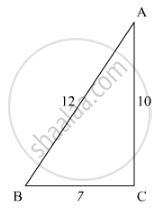Advertisements
Advertisements
प्रश्न
In ∆ABC, ∠ABC = 135°. Prove that AC2 = AB2 + BC2 + 4 ar (∆ABC)
उत्तर
We have the following figure.

Let Draw an altitude AD on Extended BC
In ∆ADC, ∠D = 90°
Therefore, by Pythagoras theorem, we have
`AC^2=AD^2+DC^2`
`AC^2=AD^2+(DB+BC)^2`
`AC^2=AD^2+DB^2+BC^2+2.BC.BD` ...(i)
In ΔADB, ∠D = 90°
⇒ `AD^2 + BD^2 = AB^2`
By substituting values of equation (i)
⇒`AD^2+DB^2+BC^2+2.BC.BD = AC^2`
⇒`AB^2 + BC^2 + 2BD.BC = AC^2`
As in ΔADB, ∠DAB = 45°
⇒ AD = DB (Opposite sides are equal)
⇒`AB^2+BC^2+2.BC.BD = AC^2`
⇒`AB^2+BC^2+2.BC.AD = AC^2`
⇒`AB^2+BC^2 + 4 xx 2/4 xx AD xx BC= AC^2`
∴ `1/2 xx AD xx BC = ar(ΔABC)`
⇒ `AC^2 = AB^2 + BC^2 + 4 ar (∆ABC)`
APPEARS IN
संबंधित प्रश्न
Diagonals AC and BD of a trapezium ABCD with AB || DC intersect each other at the point O. Using similarity criterion for two triangles, show that `"OA"/"OC"="OB"/"OD"`.
In the given figure, given that ∆ABC ∼ ∆PQR and quad ABCD ∼ quad PQRS. Determine the value of x, y, z in each case.

In ∆ABC, P and Q are points on sides AB and AC respectively such that PQ || BC. If AP = 4 cm, PB = 6 cm and PQ = 3 cm, determine BC.
In ∆ABC, ∠C is an obtuse angle. AD ⊥ BC and AB2 = AC2 + 3 BC2. Prove that BC = CD.
In ∆ABC, if BD ⊥ AC and BC2 = 2 AC . CD, then prove that AB = AC.
State Pythagoras theorem and its converse.
If D, E, F are the mid-points of sides BC, CA and AB respectively of ∆ABC, then the ratio of the areas of triangles DEF and ABC is
∆ABC ∼ ∆DEF, ar(∆ABC) = 9 cm2, ar(∆DEF) = 16 cm2. If BC = 2.1 cm, then the measure of EF is
In an equilateral triangle ABC if AD ⊥ BC, then AD2 =
A chord of a circle of radius 10 cm subtends a right angle at the centre. The length of the chord (in cm) is
